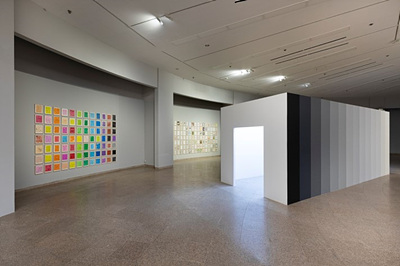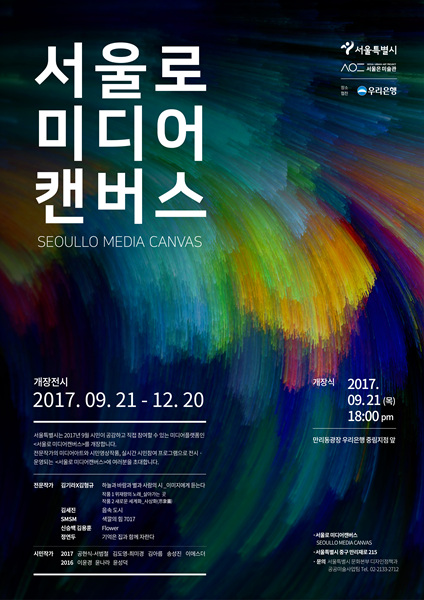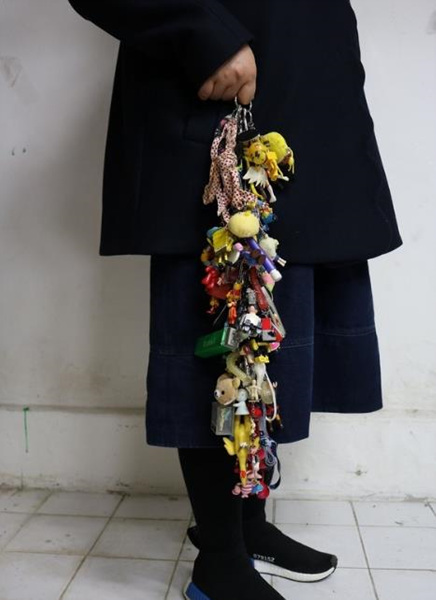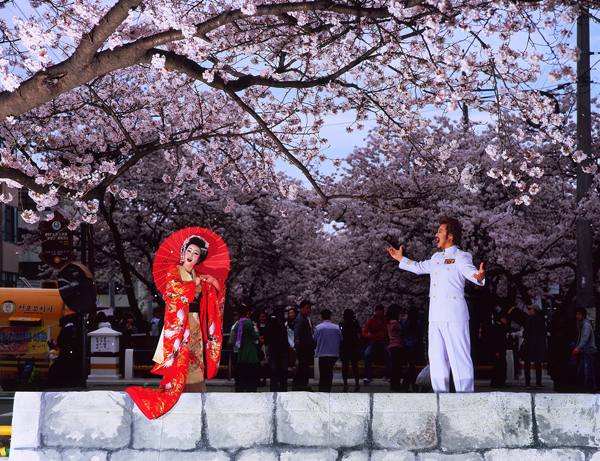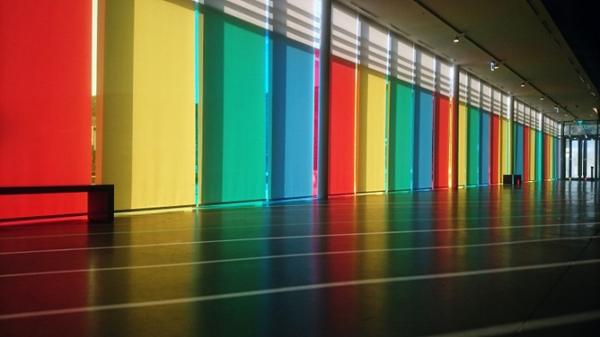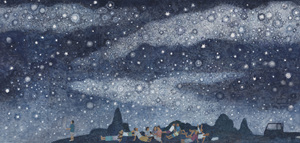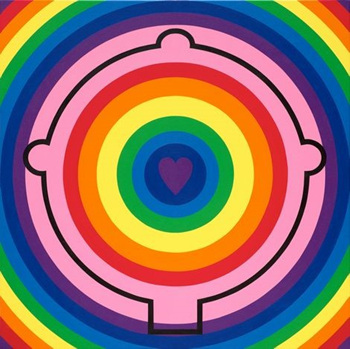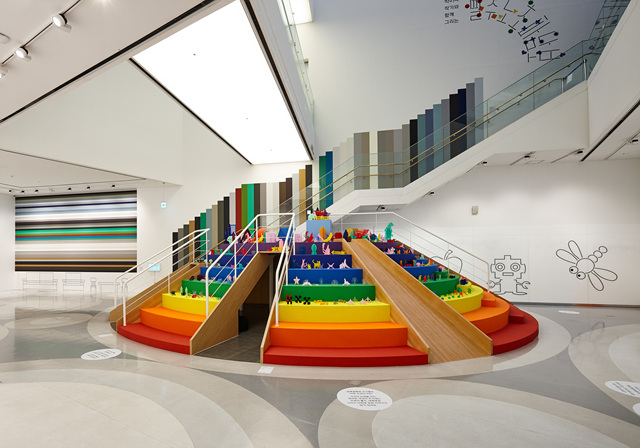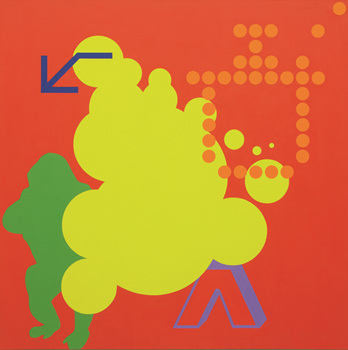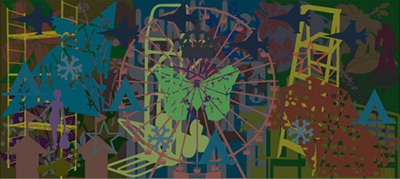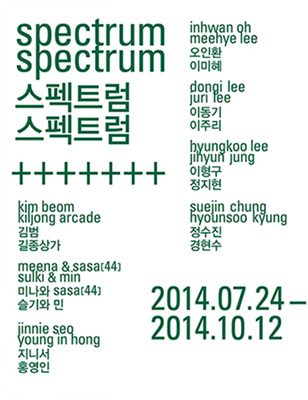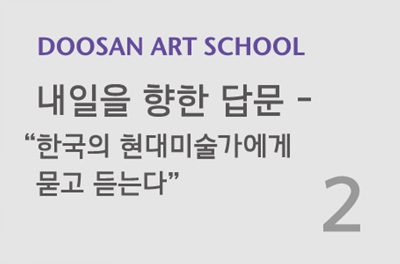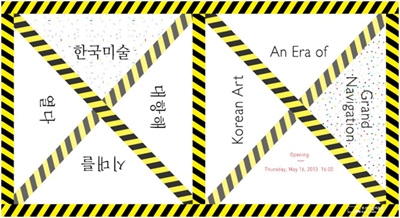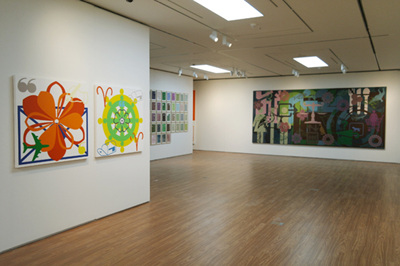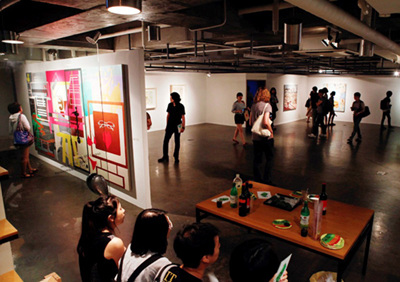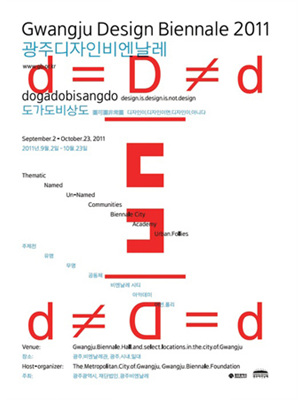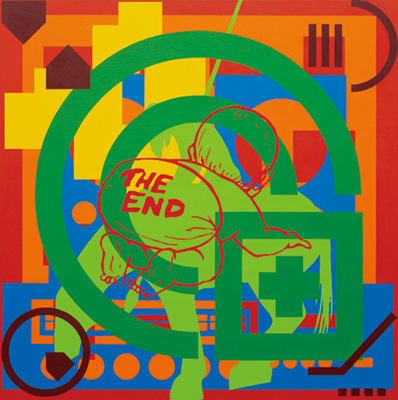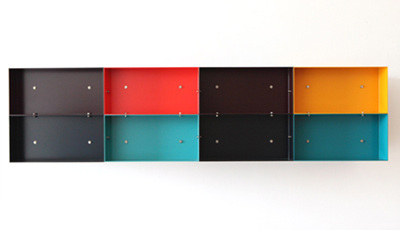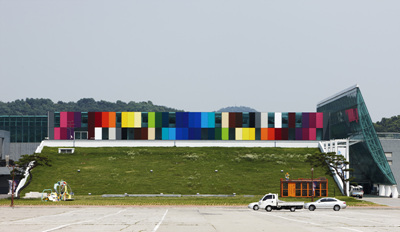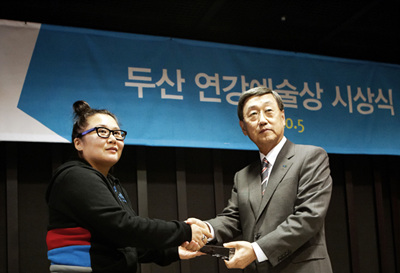 MeeNa Park,Steven Gontarsky,Suejin Chung | KUKJE GALLERY
MeeNa Park,Steven Gontarsky,Suejin Chung | KUKJE GALLERY
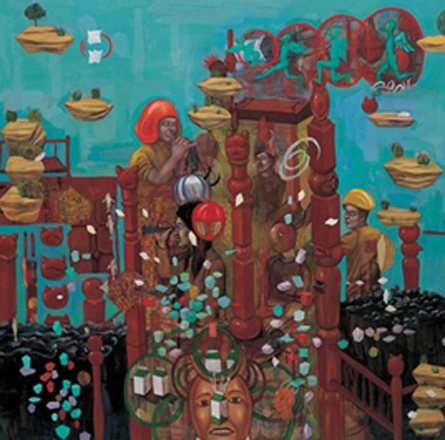
Jun 30, 2004 - Jul 21, 2004
K1
Seoul
INTRODUCTION
For the summer of 2004, Kukje Gallery has chosen three artists: Suejin Chung, Steven Gontarsky and MeeNa Park. Still in their 30s, they are highly active both at home and abroad, and known for their visual and conceptual explorations.
Since the mid-1990s, MeeNa Park has been recording her detailed studies based on her observations of everyday life and exploring how meaning is created and presented. In this exhibition, she unveils her latest projects based on her "Orange Painting" (2002), which was first shown in 2003. While this painting appears lively and bright on the surface, in fact, it is bound by numerous rules to the point of giving the observer a headache. Park's work takes off from a consideration of the conflict inherent in embodying the visual and conceptual elements of a painting. The trend of evaluating a painting by its visual appeal, as demanded by the art market, caused her to cling more and more to her "studies." How many different names and hues can be produced by a single type of color that exists as a material to make art? The artist predetermines the number of colors, the thickness of their tones, the size of the canvas and the space in which the painting will be arranged. Then the artist searches the Internet and sifts through other references until she finds the pieces of furniture that match this canvas. The result is none other than the "rules" themselves, like a puzzle fit together according to the dictates of all kinds of rules. Her paintings question us to think about how information becomes conceptualized as a separate entity from material form.
Take one look at the composition of a painting by Suejin Chung, and the notion that she paints intuitively without a preconceived order disappears. By simplifying the composition of her canvas, one can discover an exact geometrical division. Her works are a series of repetitions, consisting of divisions of up and down and divisions of left and right, on a blank, white canvas. As a result, one cannot take one's eyes off the composition or the density of colors. This is the reason why the drifting of familiar objects in a vague space appears orderly. While people are rendered realistically, they do not refer to specific people. The people who exist within the same painting have no narration to relate them to each other, nor are they gathered in a crowd. However, there is a strong sense of abundant space in her canvas because the people and the objects float separately from each other. The vague ambience of her work is also revealed in the colors. The various colors that fill out the shapes in her finely divided canvas are subdued, but one can still discover a preponderance of tones belonging to the primary colors of red and green. This has the effect of forcing the viewer to become aware of the density of the paint itself. At the same time, it causes the canvas to appear dry while helping the viewer feel the richness of colors, thus stimulating the eyes in two ways.
Steven Gontarsky adheres to the traditional methods of expression regardless of the properties of his materials. At the same time, he pursues a visual effect that somehow transcends his materials. This is revealed both in the soft space created by penetrating a form wrapped in a veil and in the highly reflective surface of high-gloss paint. We become curious about the actuality of the physical form beneath the surface and not visible to the eye. Already, a non-material attribute has been made aware visually. Gontarsky gains inspiration from and finds beauty in his cultural surroundings. Graffiti, hip-hop and skateboarding are fused with the traditional figurative sculpture to create a quality of kitsch. Furthermore, while his works seem to reflect the Classical mode of the Greek period and its idealized form, in fact, the distorted lengths and surface touches are more reminiscent of the strangeness of Mannerism, which developed after the Renaissance. This appears to be his method for approaching and understanding old legends. His work teaches us that just as myths, which are hardly realistic stories, can still reflect reality, art also embodies an unchanging value through time while at the same time reflecting the time in which it was created.
What is noteworthy about these three artists is that they all use their choice of materials to closely approximate their concepts. In the works of MeeNa Park, which explore and analyze the systems prevalent in our society, in the works of Suejin Chung, which vividly reveal the density within a canvas through various methods, and in the works of Steven Gontarsky, which follow traditional methods while at the same time expressing a slice of the unrealistic form of contemporary culture, the materials play a crucial role each in their own way. Naturally, through these works, the artists and the audience all come to ask about the true nature of art. We come to explore together the social phenomena that can be expressed by art, the expression of imagination within the consciousness, and the flow of history in pursuit of beauty.
2004년 여름, 국제갤러리에서는 정수진, 스티븐 곤타스키, 박미나 등 3명의 작가들을 선택했다. 이들은 현재 국내외로 왕성한 활동과 함께 주목받고 있는 30대 작가들로 시각적, 개념적 탐구를 깊이 있게 보여주고 있다.
박미나는 1990년대 중반부터 일상의 관찰에서 비롯된 꼼꼼한 연구를 기록하며 의미들이 어떻게 창조되고 제시되는지를 탐구하면서 페인팅을 제작한다. 이번 전시에서는 2003년 첫 선을 보였던 “오렌지 페인팅(2002년 작)”을 바탕으로 한 새로운 작업들을 보여주는데, 언뜻 보기에 발랄하고 산뜻한 이 그림이 사실은 너무 많은 부분 규칙에 얽매여 있다는 사실은 듣는 사람이 머리가 아플 정도이다. 박미나의 작업은 작품의 시각적인 부분과 개념적인 부분을 구체화하는 과정의 충돌에서 오는 고민으로부터 시작되고 있었다. 미술시장에서 요구되는 시각적 호소력이 작품의 모든 것을 평가하는 듯한 경향은 그녀를 더욱 “연구”에 집착하게 만들었다. 미술재료에 존재하는 한 가지 종류의 색채는 몇 개의 다른 이름과 색상으로 생산되는지, 이 색채의 개수를 정해놓고, 일정한 채색 두께를 정해놓고, 캔버스의 크기를 정해놓고, 그림이 배치될 일정한 스페이스의 크기를 정해놓고, 다시 작가는 이 캔버스와 매치될 수 있는 가구의 사이즈를 찾을 때 까지 인터넷을 비롯한 온갖 정보를 뒤적인다. 결과물은 그녀가 집착하고 있는, 그래서 온갖 규칙들이 적용되어 짜 맞추어진 퍼즐이 결합된 듯한 “규칙” 그 자체이다. 그녀의 그림은, 정보가 실질적인 형상에서 완전히 분리된 것으로서 어떤 과정을 통해 개념화 되어 가고 있는지에 대해 생각하게 만든다.
정수진 화면의 짜임새를 살펴보면 그녀가 직관을 이용하여 두서없이 그렸다는 선입견은 사라진다. 그녀의 화면 구도를 단순화 시키면 정확한 기하학적인 분할을 찾을 수 있을 것이다. 그녀의 작업은 텅 빈 흰색 캔버스 위에서 끊임없이 아래 위가 분할되고 좌우가 분할되는 반복의 중첩이다. 그리하여 작품의 구도나 색채에서 보여지는 밀도에 관객들은 눈을 떼지 못하게 된다. 모호한 공간 속의 익숙한 사물들의 배회가 왠지 규칙적으로 보이는 것은 아마도 이렇게 생성된 결과 인 듯 하다. 인물은 사실적으로 표현되었으나 구체적인 인물은 아니라고 한다. 한 화면 속에 존재하는 인물들은 서로 연관을 가지는 나래이션도 없고 군중으로 몰려있는 것도 아니다. 하지만 이 화면에서 드러나는 풍부한 공간감 또한 인물과 사물들이 각기 따로 부유하고 있기 때문일 것이다. 그녀의 작품에서 풍기는 모호한 기분은 색채에서도 드러난다. 잘게 분할된 화면 속 형태들을 채워나가는 다양한 색채들이 차분하지만 유난히 붉은 색이나 녹색 계열의 원색을 많이 사용하고 있음을 발견할 수 있다. 이는 진한 농도의 물감 자체를 인식하게 하는 효과를 보여주며 화면을 건조하게 보이면서도 그 풍부한 색감을 동시에 느끼게 하여 이중적으로 관객의 시선을 자극한다.
스티븐 곤타스키는 어떤 성질을 지닌 어떠한 성질의 재료를 사용하든지 표현방법 자체는 전통적인 방식을 고수하며, 동시에 탈물질화된 시각적인 효과를 추구한다. 이는 베일에 싸인 형상을 관통하여 생기는 부드러운 공간과 작품 표면에서 드러나는 고광택의 반짝임에서 보여진다. 관객은 눈에 보이지 않는 표면 아래의 불확실한 존재에 대해 호기심을 가지게 된다. 이미 시각적으로 비물질성이 인식되는 순간이다. 곤타스키는 주변에서 영감을 얻고 아름다움을 찾는다. 그래피티, 힙합, 스케이트보드타기 등은 그가 빌어온 고전 조각의 형상과 결합되면서 키치적 특색을 만들어낸다. 더 나아가 그의 작업은 그리스 시대의 고전 양식과 그 시대에 추구되었던 이상적 형태를 반영하는 듯하지만 왜곡된 길이와 표면 처리는 오히려 르네상스 시대 이후 발달한 매너리즘적인 기괴함을 연상시킨다. 이는 전설에 접근하고 이해하기 위한 그만의 방식인 듯이 보인다. 비현실적인 이야기지만 어느 시대, 어느 현실이든 비유될 수 있는 신화의 이야기는 마치 미술이 어느 시대이든 변하지 않는 가치를 지닌채 동시대를 반영해 왔다는 또 하나의 교훈을 전하는 듯하다.
이들 세 명의 작가들에게서 주목할만한 공통점은 재료를 이용하여 그들의 개념을 최대한 근접시키고 있다는 것이다. 사회적으로 만연한 제도 속을 탐험하고 분석하는 박미나의 작업 속에서도, 화면속의 밀도를 여러 방식으로 강하게 드러내는 정수진의 작업 속에서도, 전통 방식을 따르지만 현 문화의 모습의 단면과 비현실적 형상을 추구하는 곤타스키의 작업 속에서도 재료는 각기 다른 방식으로 그 핵심적인 역할을 하고 있는 것이다. 자연스럽게, 이들의 작품들을 통해 작가나 관객, 그리고 기획자들은 미술의 본질을 묻게 된다. 미술이 표현할 수 있는 사회적 현상과, 의식세계 속의 상상력의 표현과 미에 대한 추구를 위한 역사적인 흐름을 함께 탐구하게 되는 것이다.
Since the mid-1990s, MeeNa Park has been recording her detailed studies based on her observations of everyday life and exploring how meaning is created and presented. In this exhibition, she unveils her latest projects based on her "Orange Painting" (2002), which was first shown in 2003. While this painting appears lively and bright on the surface, in fact, it is bound by numerous rules to the point of giving the observer a headache. Park's work takes off from a consideration of the conflict inherent in embodying the visual and conceptual elements of a painting. The trend of evaluating a painting by its visual appeal, as demanded by the art market, caused her to cling more and more to her "studies." How many different names and hues can be produced by a single type of color that exists as a material to make art? The artist predetermines the number of colors, the thickness of their tones, the size of the canvas and the space in which the painting will be arranged. Then the artist searches the Internet and sifts through other references until she finds the pieces of furniture that match this canvas. The result is none other than the "rules" themselves, like a puzzle fit together according to the dictates of all kinds of rules. Her paintings question us to think about how information becomes conceptualized as a separate entity from material form.
Take one look at the composition of a painting by Suejin Chung, and the notion that she paints intuitively without a preconceived order disappears. By simplifying the composition of her canvas, one can discover an exact geometrical division. Her works are a series of repetitions, consisting of divisions of up and down and divisions of left and right, on a blank, white canvas. As a result, one cannot take one's eyes off the composition or the density of colors. This is the reason why the drifting of familiar objects in a vague space appears orderly. While people are rendered realistically, they do not refer to specific people. The people who exist within the same painting have no narration to relate them to each other, nor are they gathered in a crowd. However, there is a strong sense of abundant space in her canvas because the people and the objects float separately from each other. The vague ambience of her work is also revealed in the colors. The various colors that fill out the shapes in her finely divided canvas are subdued, but one can still discover a preponderance of tones belonging to the primary colors of red and green. This has the effect of forcing the viewer to become aware of the density of the paint itself. At the same time, it causes the canvas to appear dry while helping the viewer feel the richness of colors, thus stimulating the eyes in two ways.
Steven Gontarsky adheres to the traditional methods of expression regardless of the properties of his materials. At the same time, he pursues a visual effect that somehow transcends his materials. This is revealed both in the soft space created by penetrating a form wrapped in a veil and in the highly reflective surface of high-gloss paint. We become curious about the actuality of the physical form beneath the surface and not visible to the eye. Already, a non-material attribute has been made aware visually. Gontarsky gains inspiration from and finds beauty in his cultural surroundings. Graffiti, hip-hop and skateboarding are fused with the traditional figurative sculpture to create a quality of kitsch. Furthermore, while his works seem to reflect the Classical mode of the Greek period and its idealized form, in fact, the distorted lengths and surface touches are more reminiscent of the strangeness of Mannerism, which developed after the Renaissance. This appears to be his method for approaching and understanding old legends. His work teaches us that just as myths, which are hardly realistic stories, can still reflect reality, art also embodies an unchanging value through time while at the same time reflecting the time in which it was created.
What is noteworthy about these three artists is that they all use their choice of materials to closely approximate their concepts. In the works of MeeNa Park, which explore and analyze the systems prevalent in our society, in the works of Suejin Chung, which vividly reveal the density within a canvas through various methods, and in the works of Steven Gontarsky, which follow traditional methods while at the same time expressing a slice of the unrealistic form of contemporary culture, the materials play a crucial role each in their own way. Naturally, through these works, the artists and the audience all come to ask about the true nature of art. We come to explore together the social phenomena that can be expressed by art, the expression of imagination within the consciousness, and the flow of history in pursuit of beauty.
2004년 여름, 국제갤러리에서는 정수진, 스티븐 곤타스키, 박미나 등 3명의 작가들을 선택했다. 이들은 현재 국내외로 왕성한 활동과 함께 주목받고 있는 30대 작가들로 시각적, 개념적 탐구를 깊이 있게 보여주고 있다.
박미나는 1990년대 중반부터 일상의 관찰에서 비롯된 꼼꼼한 연구를 기록하며 의미들이 어떻게 창조되고 제시되는지를 탐구하면서 페인팅을 제작한다. 이번 전시에서는 2003년 첫 선을 보였던 “오렌지 페인팅(2002년 작)”을 바탕으로 한 새로운 작업들을 보여주는데, 언뜻 보기에 발랄하고 산뜻한 이 그림이 사실은 너무 많은 부분 규칙에 얽매여 있다는 사실은 듣는 사람이 머리가 아플 정도이다. 박미나의 작업은 작품의 시각적인 부분과 개념적인 부분을 구체화하는 과정의 충돌에서 오는 고민으로부터 시작되고 있었다. 미술시장에서 요구되는 시각적 호소력이 작품의 모든 것을 평가하는 듯한 경향은 그녀를 더욱 “연구”에 집착하게 만들었다. 미술재료에 존재하는 한 가지 종류의 색채는 몇 개의 다른 이름과 색상으로 생산되는지, 이 색채의 개수를 정해놓고, 일정한 채색 두께를 정해놓고, 캔버스의 크기를 정해놓고, 그림이 배치될 일정한 스페이스의 크기를 정해놓고, 다시 작가는 이 캔버스와 매치될 수 있는 가구의 사이즈를 찾을 때 까지 인터넷을 비롯한 온갖 정보를 뒤적인다. 결과물은 그녀가 집착하고 있는, 그래서 온갖 규칙들이 적용되어 짜 맞추어진 퍼즐이 결합된 듯한 “규칙” 그 자체이다. 그녀의 그림은, 정보가 실질적인 형상에서 완전히 분리된 것으로서 어떤 과정을 통해 개념화 되어 가고 있는지에 대해 생각하게 만든다.
정수진 화면의 짜임새를 살펴보면 그녀가 직관을 이용하여 두서없이 그렸다는 선입견은 사라진다. 그녀의 화면 구도를 단순화 시키면 정확한 기하학적인 분할을 찾을 수 있을 것이다. 그녀의 작업은 텅 빈 흰색 캔버스 위에서 끊임없이 아래 위가 분할되고 좌우가 분할되는 반복의 중첩이다. 그리하여 작품의 구도나 색채에서 보여지는 밀도에 관객들은 눈을 떼지 못하게 된다. 모호한 공간 속의 익숙한 사물들의 배회가 왠지 규칙적으로 보이는 것은 아마도 이렇게 생성된 결과 인 듯 하다. 인물은 사실적으로 표현되었으나 구체적인 인물은 아니라고 한다. 한 화면 속에 존재하는 인물들은 서로 연관을 가지는 나래이션도 없고 군중으로 몰려있는 것도 아니다. 하지만 이 화면에서 드러나는 풍부한 공간감 또한 인물과 사물들이 각기 따로 부유하고 있기 때문일 것이다. 그녀의 작품에서 풍기는 모호한 기분은 색채에서도 드러난다. 잘게 분할된 화면 속 형태들을 채워나가는 다양한 색채들이 차분하지만 유난히 붉은 색이나 녹색 계열의 원색을 많이 사용하고 있음을 발견할 수 있다. 이는 진한 농도의 물감 자체를 인식하게 하는 효과를 보여주며 화면을 건조하게 보이면서도 그 풍부한 색감을 동시에 느끼게 하여 이중적으로 관객의 시선을 자극한다.
스티븐 곤타스키는 어떤 성질을 지닌 어떠한 성질의 재료를 사용하든지 표현방법 자체는 전통적인 방식을 고수하며, 동시에 탈물질화된 시각적인 효과를 추구한다. 이는 베일에 싸인 형상을 관통하여 생기는 부드러운 공간과 작품 표면에서 드러나는 고광택의 반짝임에서 보여진다. 관객은 눈에 보이지 않는 표면 아래의 불확실한 존재에 대해 호기심을 가지게 된다. 이미 시각적으로 비물질성이 인식되는 순간이다. 곤타스키는 주변에서 영감을 얻고 아름다움을 찾는다. 그래피티, 힙합, 스케이트보드타기 등은 그가 빌어온 고전 조각의 형상과 결합되면서 키치적 특색을 만들어낸다. 더 나아가 그의 작업은 그리스 시대의 고전 양식과 그 시대에 추구되었던 이상적 형태를 반영하는 듯하지만 왜곡된 길이와 표면 처리는 오히려 르네상스 시대 이후 발달한 매너리즘적인 기괴함을 연상시킨다. 이는 전설에 접근하고 이해하기 위한 그만의 방식인 듯이 보인다. 비현실적인 이야기지만 어느 시대, 어느 현실이든 비유될 수 있는 신화의 이야기는 마치 미술이 어느 시대이든 변하지 않는 가치를 지닌채 동시대를 반영해 왔다는 또 하나의 교훈을 전하는 듯하다.
이들 세 명의 작가들에게서 주목할만한 공통점은 재료를 이용하여 그들의 개념을 최대한 근접시키고 있다는 것이다. 사회적으로 만연한 제도 속을 탐험하고 분석하는 박미나의 작업 속에서도, 화면속의 밀도를 여러 방식으로 강하게 드러내는 정수진의 작업 속에서도, 전통 방식을 따르지만 현 문화의 모습의 단면과 비현실적 형상을 추구하는 곤타스키의 작업 속에서도 재료는 각기 다른 방식으로 그 핵심적인 역할을 하고 있는 것이다. 자연스럽게, 이들의 작품들을 통해 작가나 관객, 그리고 기획자들은 미술의 본질을 묻게 된다. 미술이 표현할 수 있는 사회적 현상과, 의식세계 속의 상상력의 표현과 미에 대한 추구를 위한 역사적인 흐름을 함께 탐구하게 되는 것이다.
